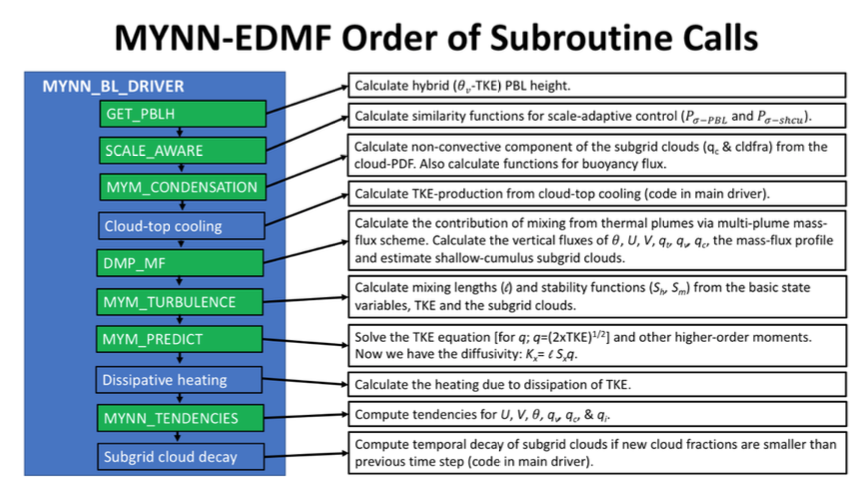The Mellor-Yamada-Nakanishi-Niino (Nakanishi and Niino 2009 [141]) eddy diffusivity-mass flux (EDMF) scheme was implemented into CCPP to introduce an alternative turbulent kinetic energy (TKE)-based planetary boundary layer (PBL) scheme which could serve as a candidate PBL parameterization for future operational implementations of the Unified Forecast System. The MYNN-EDMF is currently employed in NOAA's operational Rapid Refresh (RAP; Benjamin et al.2016 [24]) and High-Resolution Rapid Refresh (HRRR) forecast systems.
The original MYNN scheme was demonstrated to be an improvement over predecessor Mellor-Yamada-type PBL schemes (e.g., Mellor and Yamada 1974,1982 [130] [131]) when compared against large-eddy simulation (LES) of a convective PBL (Nakanishi and Niino 2004, 2009 [139] [141]), the prediction of advection fog (Nakanishi and Niino 2006 [140]), and for the representation of coastal barrier jets (Olson and Brown 2009 [148]). The MYNN scheme can be configured to function at level 2.5, 2.6 (current default) or 3.0 closure and includes a partial-condensation scheme (also known as a cloud PDF or a statistical-cloud scheme) to represent the effects of subgrid-scale(SGS) clouds on the buoyancy flux (Nakanishi and Niino 2004, 2006, and 2009 [139] [140] [141]). The closure constants for the original MYNN scheme were tuned to a database of LES as opposed to observational data.
The MYNN-EDMF scheme has been extensively developed to improve upon the forecast skill of the original MYNN, largely driven by requirements to improve forecast skill in support of the NOAA's National Weather Service (NWS), the Federal Aviation Administration (FAA) and users within the renewable-energy industry.Specifically, fundamental changes were made to the formulation of the mixing lengths and representation of subgrid-scale(SGS) clouds, but new components have also been added to improve the representation of non-local mixing, the turbulence interaction with clouds, and the coupling to other model components (i.e., radiation). A description of the changes to the MYNN scheme are available in Olson et al.(2019) [149].
icloud_bl is set to 1. In this case, the SGS cloud fraction, CLDFRA_BL, and the SGS cloud-mixing ratio, QC_BL, are added to the microphysics arrays within the radiation driver (mynnrad_pre_run()). The following two steps are performed:(1) the cloud fraction of the resolved-scale clouds are computed, using Xu and Randal (1996) [191] by default;
(2) if the resolved-scale cloud liquid ( \(q_c\)) or ice ( \(q_i\)), is less than \(10^{-6}kg kg^{-1}\) and \(10^{-8}kg kg^{-1}\), respectively, and there exists a nonzero SGS cloud fraction, then the SGS components are added to their respective resolved-scale components by a temperature weighting, according to linear approximation of Hobbs et al.(1974) [88] :
\[ W_{ice}=1-min(1,max(0,(T-254)/15)) W_{h2o}=1-W_{ice} \]
Then we sort the SGS cloud water and liquid as :
\(q_c\)=QC_BL* \(W_{h2o}\)*CLDFRA_BL
\(q_i\)=QC_BL* \(W_{ice}\)*CLDFRA_BL
This allows us to only use one 3-D array for both SGS cloud water and ice. The updated \(q_{c}\), \(q_{i}\), and CLDFRA are then used as input into the radiation schemes. After exiting the radiation schemes, the original values of \(q_c, q_i\) and CLDFRA are restored, so the SGS clouds do not impact the resolved-scale moisture budget.
The MYNN-EDMF CCPP-compliant interface: Argument Table
